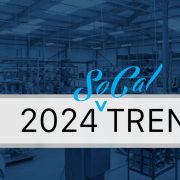AI Streamlining Site Selection, Planning, and Development Processes
In a previous blog post on AI, we discussed the myriad ways it will impact the commercial real estate industry — from property valuation and market analysis to predictive analytics to facilities management. As the technology continues to advance, so will its practical applications, and the commercial real estate development community is taking notice. According to a 2024 study by Deloitte, 72% of real estate owners and investors are committed to investing in AI-assisted solutions in 2024.
At the recent SIOR Spring Conference held at Amelia Beach off the coast of northern Florida (nearly two dozen VOIT brokers have earned the designation of SIOR, awarded by the Society of Industrial and Office Realtors to top performers in industrial and office real estate), representatives from Langan Engineering and Environmental Services gave a comprehensive presentation on the efficiencies that AI will bring to the design and construction process of properties. The possibilities are mind-boggling. Led by Brett Milburn, director of digital solutions for the firm, the session, “Real Estate Reimagined — AI’s Influence on Design, Building, and Operations,” focused on how developers can use AI for site selection, site analysis, and decision-making.
The Site Development Process

“AI site selection leverages data-driven insights to streamline the real estate development process,” Andrew Breeding, Senior GIS Programmer at Langan, explained during his overview. With their ability to process vast amounts of data from various sources, AI systems can uncover historical trends and patterns at a local level that would be challenging for humans to identify manually — in a fraction of the time. These intelligent systems can automate the analysis of legal documents, contracts, and environmental reports, quickly identifying potential risks, zoning issues, and compliance requirements. The technology’s predictive analytics can forecast future market conditions, allowing developers to make more informed decisions by considering location, site size, accessibility, and other factors. AI significantly reduces the risk of human error in the due diligence process and can identify potential red flags that would be difficult to detect through traditional methods, enabling developers to make a “go or no-go” decision well before investing time and resources in a project. AI can even forecast the likely outcome and return on investment for a particular site, providing a level of certainty for investors.
Planning and Design

One of AI’s many benefits is its ability to help developers and investors evaluate multiple development scenarios to determine which project can deliver the most value. In the planning and design phases, generative AI can cycle through hundreds of development scenarios for a project site, providing visualizations, value metrics, and insights into potential development options. This allows stakeholders to make informed decisions and quickly assess the feasibility and profitability of different development options.
Design tech specialist Adam Kent showed the audience how generative AI works in real time, with the system generating multiple project ideas on a hypothetical site located alongside a river. “Generative AI can cycle through ideas and give you different iterations of that idea,” he said, which allows investors to find the most valuable and feasible options for a project site.
Those ideas included an office project, big-box retail, a data center, a warehouse facility with trailer parking, and options for apartments or single-family homes, each project with different configurations — all in a matter of minutes. “By going through these different scenarios, generative AI is going to give us a better idea of what will fit on this project site,” said Kent. He cautioned that this analysis would still be incomplete, not necessarily accounting for variables such as additional traffic loads that a project would generate or zoning, “but it’s just kind of directionally accelerating us with some ideas and getting the ideas flowing.” Each developer can then determine what project type would work best for them based on their expertise and portfolio strategy.

After reviewing the various project options, Kent rhetorically asked the audience: “How quickly would you have been able to draw up your idea to give to your architects and engineers and say, ‘Hey, this is what I’m looking for.’” Generative AI allows for visualizations of projects based on the selected property type and cost metrics, including the expenses associated with the property type, hard and soft costs, land, and construction cost estimates based on current data. “You get to visualize those [items]… and make better decisions a lot quicker on the planning side.”
Kent emphasized that many different Generative AI planning software packages are available, each with distinct capabilities.
AI in the Design Phase
With the project type selected, Generative AI can help determine its feasibility from a design perspective. Users can input data for the project site and receive multiple design solutions along with associated cost values. Kent cited the example of determining the earthwork process for a project. While earthwork calculations can be done manually, generative AI can run through thousands of iterations to find the most optimal solutions and identify cost-saving opportunities that may not be apparent to human engineers. For example, it could theoretically determine that placing a retaining wall in a specific location would potentially save millions of dollars in earthwork costs.
AI is not a Panacea
While AI is a powerful tool, it’s not meant to replace human work, only to augment it. It also comes with its own risk — points that the presenters drove home at the session’s conclusion. “AI does not replace the human factor,” said senior project manager Eric Wittner during his wrap-up. “There are lots of instances where AI is great, but it’s a tool, and right now, you can’t rely on just the tool. It’s there to augment how you work, not to replace you.”
Overall, AI is transforming development by streamlining planning, design, monitoring, and management processes, ultimately improving efficiency and decision-making of investors and developers. Those who strategically adopt and integrate AI into their operations stand to gain significant advantages over their competitors.









